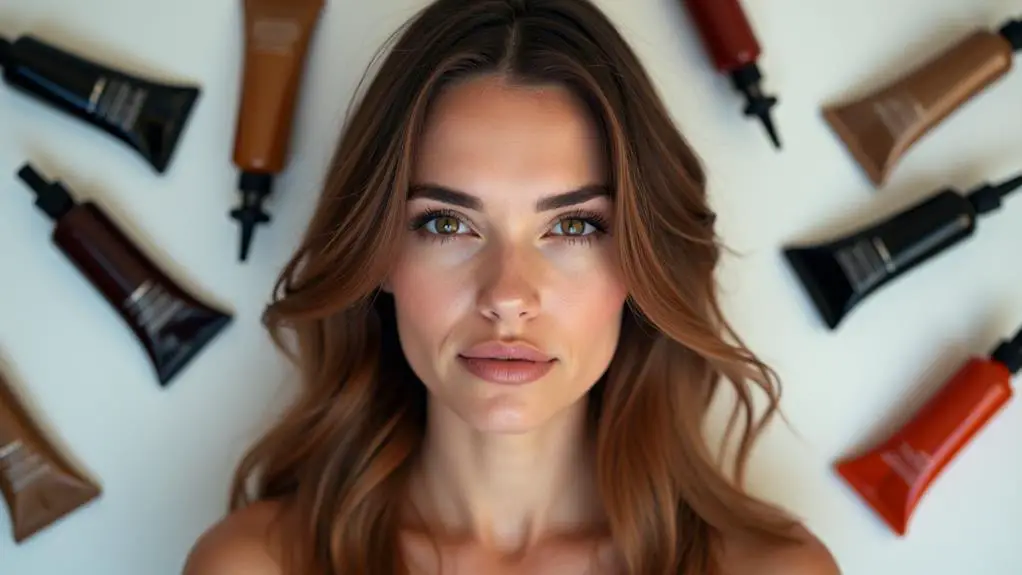So, you're thinking of dyeing your hair, but you're wondering if you can get away with doing it with oil still in your locks. Well, here's the thing: oil can seriously impact the dyeing process, and not in a good way. When you've got oil buildup on your hair, it creates a barrier that can prevent the dye from penetrating evenly, leading to patchy, lackluster results. But don't worry, there are ways to overcome this hurdle. You'll want to know how to properly prep your hair before dyeing, and that's where things get interesting…
Key Takeaways
- Hair oil can slow down dye absorption, leading to less vibrant colors and patchy results, making it challenging to achieve desired hair color.
- The type of oil used affects hair dye results, with lighter oils like argan and jojoba oil allowing for better dye penetration than thicker oils like coconut and olive oil.
- Failing to remove excess oil before dyeing can lead to uneven color distribution, reduced color longevity, and increased risk of color fade.
- Removing excess oil with a clarifying shampoo and micro-exfoliating treatments can help ensure even dye penetration and more vibrant color results.
- Using the right oil-based hair products and treatments before dyeing can help protect hair from damage, promote healthy growth, and enhance color deposit.
Understanding Hair Oil and Dye
When delving into the world of hair dyeing with oil, it's vital to comprehend the intricate relationship between hair oil and dye.
You need to understand how hair oil affects your hair's ability to absorb and hold onto dye molecules. Hair porosity plays a significant role in this process. If your hair has low porosity, the oil can create a barrier, making it difficult for the dye to penetrate. On the other hand, high porosity hair may absorb too much oil, leading to uneven color distribution.
You also need to ponder hair elasticity, which affects how well your hair can withstand the dyeing process. If your hair has poor elasticity, it may be prone to breakage when exposed to dye, especially if you're using permanent dyes.
How Oil Affects Hair Dye Results
When you use oil to dye your hair, the oil coats the hair shaft, which slows down dye absorption and alters the color deposit.
As a result, you may notice that the dye takes longer to penetrate the hair, leading to a more subtle color outcome.
Additionally, the oil can also affect the final color tone, making it richer or more muted, depending on the type of oil used.
Oil Coats Hair Shaft
As you apply oil to your hair before dyeing, it forms a coating along the hair shaft, which drastically alters the way the dye interacts with your hair.
This coating affects the hair's porosity, making it more challenging for the dye to penetrate the hair shaft evenly.
Here's how the oil coating impacts your hair dye results:
- Reduced dye uptake: The oil coating reduces the hair's ability to absorb the dye, resulting in less vibrant colors and potentially patchy results.
- Altered color distribution: The oil can cause the dye to distribute unevenly, leading to inconsistent color tone and saturation.
- Increased risk of color fade: The oil coating can also reduce the color's longevity, causing it to fade faster.
- Influence on oil affinity: The type of oil used can affect how well it coats the hair shaft, with some oils having a stronger affinity for hair than others.
Understanding how oil coats the hair shaft is vital in achieving the desired hair dye results.
Slows Down Dye Absorption
The oil coating created along the hair shaft plays a substantial role in slowing down dye absorption.
This is because the oil layer acts as a barrier, reducing the hair's porosity and limiting the penetration of dye molecules. As a result, the dye molecules struggle to penetrate the hair shaft, leading to slower and less even color deposition.
This can lead to uneven color distribution, faded color, or even no color at all.
When you apply hair dye to oiled hair, the oil molecules repel the water-based dye molecules, causing them to aggregate on the surface of the hair rather than penetrating the shaft.
This reduces the amount of dye that's absorbed, resulting in a less intense color. In addition, the oil coating can also affect the way the dye molecules bind to the hair, leading to a weaker color bond that's more prone to fading.
Alters Color Deposit
Most of the dye molecules that do manage to penetrate the hair shaft encounter an altered environment, which affects how they deposit color.
This altered environment is a result of the oil's presence, which changes the way the dye molecules interact with your hair.
According to Color Theory, the interaction between the dye molecules and your hair's porosity plays a vital role in determining the final color outcome.
When oil is present, it changes the porosity of your hair, affecting how the dye molecules deposit color.
- Reduced color intensity: Oil can dilute the concentration of dye molecules, resulting in a less vibrant color.
- Unpredictable color tone: Oil can alter the way dye molecules bind to your hair, leading to an unpredictable color tone.
- Increased color fade: Oil can cause the dye molecules to wash out faster, resulting in faster color fade.
- Inconsistent color distribution: Oil can affect the even distribution of dye molecules, leading to an inconsistent color result.
Keep in mind that the extent of these effects depends on the type of oil, the amount used, and your hair's porosity.
Types of Oils and Their Impact
Several oils can be used for hair dyeing, each with its unique characteristics and effects.
You'll find that oil properties, such as viscosity, pH level, and molecular weight, influence how well they penetrate your hair shaft.
For instance, lighter oils like argan and jojoba oil have smaller molecules, allowing them to easily seep into your hair's cortex, whereas thicker oils like coconut and olive oil may struggle to penetrate, resulting in uneven color distribution.
When choosing an oil, consider your hair's porosity.
If you have low porosity hair, you may want to opt for lighter oils that won't weigh your hair down.
On the other hand, if you have high porosity hair, thicker oils can help lock in moisture and reduce frizz.
Keep in mind that some oils, like tea tree oil, can even affect the pH balance of your scalp, potentially irritating it.
Pre-Dye Oil Removal Methods
Before dyeing your hair with oil, you'll need to remove excess oil from your locks.
To do this, you can wash your hair with a clarifying shampoo, use oil-absorbing products like clay masks or dry shampoos, or try micro-exfoliating treatments to gently remove residue.
Wash With Clarifying Shampoo
You'll typically start the pre-dye oil removal process by washing your hair with a clarifying shampoo, a crucial step that sets the stage for successful dyeing.
This type of shampoo is specifically designed to remove product buildup, dirt, and oils from your hair, allowing the dye to penetrate more evenly.
In your regular hair care routine, you may use moisturizing or nourishing shampoos, but clarifying shampoos are essential for pre-dye preparation.
When washing your hair with a clarifying shampoo:
- Choose a sulfate-based clarifying shampoo: Sulfates are effective at stripping oils and product buildup from your hair.
- Wash your hair twice: This confirms that all oils and residue are removed, allowing the dye to adhere better.
- Focus on the scalp: Massage the shampoo into your scalp to remove oils and dirt that can affect dye penetration.
- Rinse thoroughly: Remove all shampoo residue to prevent any remaining oils or product buildup from interfering with the dye.
Use Oil-Absorbing Products
Your hair, now stripped of its natural oils and product buildup, is ready for the next step in the pre-dye oil removal process.
This step involves using oil-absorbing products to further remove excess oil from your hair. These products are specifically designed to absorb and remove excess oil without stripping your hair of its natural moisture.
This is especially important, as you want to maintain the oil benefits that are essential for healthy hair.
When choosing an oil-absorbing product, look for one that's gentle and formulated for your hair type.
Apply the product to your hair, focusing on the scalp and mid-lengths where oil tends to accumulate. Massage the product into your hair, then rinse thoroughly with warm water.
Repeat the process if necessary, until your hair feels clean and oil-free.
Try Micro-Exfoliating Treatments
The pre-dye oil removal process takes another crucial step forward with micro-exfoliating treatments.
You're now one step closer to achieving ideal hair dye results. These treatments focus on gently removing excess oil and product buildup from your scalp, allowing the dye to penetrate more evenly.
Micro-exfoliating treatments offer several benefits, including:
- Enhanced exfoliating benefits: Removing dead skin cells and product buildup helps to unclog pores and promote healthy hair growth.
- Scalp rejuvenation: Exfoliating your scalp stimulates blood flow, reducing irritation and itchiness.
- Improved oil removal: Micro-exfoliating treatments help to break down and remove excess oil, ensuring a clean canvas for dye application.
- Better dye adhesion: By removing impurities and excess oils, your hair becomes more receptive to the dye, resulting in more vibrant, long-lasting color.
Oil-Based Hair Products and Dye
Since ancient times, people have been using oil-based hair products to moisturize, nourish, and protect their locks.
You've likely used oil-based hair masks to deep condition and repair your hair. These products can provide numerous benefits, including locking in moisture, reducing frizz, and enhancing shine.
When it comes to dyeing your hair with oil in it, understanding how oil-based products interact with dye is vital.
Oil-based hair products can affect the dyeing process in several ways. For instance, they can create a barrier on the hair shaft, which may prevent the dye from penetrating evenly.
This can result in uneven color distribution or a less vibrant color. On the other hand, some oil-based products can help to open up the hair cuticle, allowing the dye to penetrate more easily.
It's imperative to weigh the type of oil-based product you're using and how it may impact the dyeing process. By doing so, you can achieve the best possible results and minimize any potential issues.
Best Oils for Pre-Dye Hair Care
When preparing your hair for dyeing, choosing the right oil-based product can make a significant difference in the outcome.
As part of your pre-dye hair care routine, incorporating the right oils can help nourish and protect your hair, leading to a more successful dye job.
Here are some of the best oils to use as part of your pre-treatment rituals:
- Coconut oil: Rich in nutrients and antioxidants, coconut oil helps to moisturize and condition your hair, making it more receptive to dye.
- Olive oil: With its high levels of antioxidants and fatty acids, olive oil helps to protect your hair from damage and promote healthy growth.
- Argan oil: This luxurious oil is rich in vitamins and minerals, helping to hydrate and smooth your hair, making it ideal for hair masks and pre-treatment rituals.
- Jojoba oil: Similar in composition to the natural oils produced by your scalp, jojoba oil helps to balance and regulate your hair's natural moisture levels, making it an excellent choice for pre-dye hair care.
Dyeing Over Oily Hair Concerns
One major concern when dyeing hair is dealing with oily locks, as excess oil can hinder the dye's ability to penetrate the hair shaft evenly. This can lead to uneven color distribution, resulting in dye disasters that compromise hair health. You may end up with patchy, brittle, or even broken hair.
| Oil Level | Dyeing Concerns |
|---|---|
| Low | Even dye penetration, ideal color results |
| Moderate | Slightly uneven dye penetration, potential for subtle color variations |
| High | Hindered dye penetration, increased risk of dye disasters |
| Excessive | Severe dye penetration issues, high risk of hair damage and breakage |
When you dye over oily hair, you risk exacerbating existing hair health issues. Excess oil can also cause the dye to sit on the surface of your hair, rather than penetrating the shaft. This can lead to an uneven color tone and reduced color vibrancy. To avoid these issues, it is crucial to address oily hair concerns before dyeing.
Preventing Damage From Oil and Dye
To prevent damage from oil and dye, you must take proactive steps to address oily hair concerns before dyeing.
Oily hair can lead to uneven color distribution, reduced color vibrancy, and increased risk of damage.
To guarantee hair protection and proper hair preparation, follow these essential steps:
1. Wash your hair: Remove excess oil by washing your hair with a clarifying shampoo 24-48 hours before dyeing.
This helps open up the hair cuticle, allowing the dye to penetrate more evenly.
2. Use a pre-dye treatment: Apply a pre-dye treatment containing ingredients like keratin or argan oil to help lock in moisture and protect your hair from damage.
3. Towel-dry, don't blow-dry: Air-dry your hair or gently blot it with a microfiber towel to prevent heat damage and excessive oil production.
4. Choose the right dye: Select a dye specifically formulated for oily hair or those with moisturizing properties to minimize damage and promote healthy-looking hair.
Choosing the Right Hair Dye
| Dye Type | Hair Concerns | Ingredients |
|---|---|---|
| Permanent | Dryness, color fade | Ammonia, paraphenylenediamine |
| Semi-Permanent | Frizz, damage | No ammonia, gentler alternatives |
| Temporary | None, just color enhancement | No harsh chemicals, natural ingredients |
| Natural | All, gentle and nourishing | Plant-based, natural oils |
When selecting a dye, think about the level of maintenance you're willing to commit to. If you want a long-lasting color, permanent dyes may be the best option. However, if you're looking for a lower-maintenance option, semi-permanent or temporary dyes could be the way to go.
Post-Dye Oil-Based Hair Care Tips
After selecting the perfect hair dye, you're enthusiastic to achieve that vibrant, long-lasting color.
Now, it's crucial to focus on post-dye oil-based hair care to maintain your hair's health and color vibrancy.
To guarantee your hair looks and feels its best, follow these oil-based hair care tips:
1. Use a nourishing hair mask: Treat your hair to a hydrating mask once or twice a week to lock in moisture and color.
Look for a mask containing ingredients like coconut oil, argan oil, or olive oil.
2. Incorporate an oil treatment: Perform an oil treatment once a week to replenish your hair's natural oils.
Warm the oil by gently heating it in your hands, then massage it into your scalp and work it down to the ends.
3. Choose oil-based styling products: Opt for styling products containing oils like argan, coconut, or jojoba to help lock in moisture and color.
4. Limit heat styling: Try to minimize heat styling tools or use a heat protectant spray to prevent damage and color fade.
Frequently Asked Questions
Can I Use Oil as a Substitute for Hair Dye Conditioner?
You can't use hair oil as a substitute for hair dye conditioner, as oil won't provide the same moisturizing and color-lock benefits; instead, look for a color-lock conditioner specifically formulated to seal in color and moisture.
Does Oil in Hair Affect the Dye's Shelf Life?
When storing hair dye, you're probably more concerned about it going bad than your favorite meal expiring; however, having oil in your hair affects the dye's shelf life, compromising oil stability and ultimately dye potency, making it less effective over time.
Can I Dye My Hair With Oil if I Have a Scalp Condition?
If you have a scalp condition, you'll want to exercise caution. You're likely to experience increased scalp sensitivity, and oil buildup can exacerbate the issue. It's best to remove excess oil before dyeing to minimize irritation and guarantee a more comfortable process.
Will Oil in My Hair Change the Dye's Color Tone?
As you ponder the dye job, a critical question looms: will oil in your hair sabotage the color? Yes, it can, as oil molecules alter the dye's absorption, potentially shifting the tone and reducing color intensity, leaving you with an unintended hue.
Can I Use Oil to Remove Hair Dye From My Skin?
When removing hair dye stains from your skin, you can try using oil as a gentle cleansing agent. Apply a small amount of oil to the stained area, massage it in, and then wipe clean with a cloth for effective skin cleansing and stain removal.
Conclusion
As you prepare to dye your hair, remember that oil and dye don't mix. Failing to remove excess oil can lead to a dye disaster, compromising the final color outcome and exacerbating hair health issues. Don't let oil get in the way of achieving your desired hair color. Take the time to prep your hair properly, and you'll be rewarded with vibrant, evenly distributed color. After all, "a clean canvas is a happy canvas" – and in this case, a clean canvas means oil-free hair.














